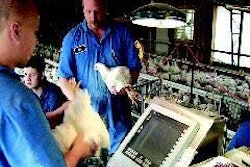
The poultry industry is no stranger to bureaucracy. Whether it concerns hygiene, grading or waste management, the legislation facing the sector seems endless. However, awareness of it amongst poultrymeat and egg producers and processors is frighteningly low. Here, we will explore what is involved and who is responsible, whilst arguing that with the right attitude, the legislation could be a blessing in disguise.
About the legislation
Many things have come under scrutiny as a result of the Kyoto Protocol and this summer, EC Regulation 842/2006 will come into force with the aim of reducing the release of certain fluorinated greenhouse gases into the atmosphere. To translate this into plain English, it means that any organisation using refrigeration equipment or chillers needs to be aware of how much fluorinated greenhouse gas (or F-Gas) it contains to understand how the ruling will impact its business.
The legislation states that any facility with a refrigerant charge of more than 3kg must undertake reasonable measures to monitor its use of F-Gas, improve containment and keep track of all activity with an auditable trail. There is a sliding scale of responsibility, with facilities containing in excess of a 300kg charge obliged to fit a fixed leak detection system, conduct regular checks and repair any leaks within a set time frame.
What will it mean for poultrymeat and egg producers?
The very nature and layout of any food processing plant means that there is likely to be a high refrigerant charge, and this is particularly true for the poultry industry. Sites with considerable lengths of pipeline where the refrigeration plant is some distance from the evaporator are especially prone to leakage. If you do not know the refrigerant charge at your facility, you need to find out. The refrigerant calculator at www.defra.gov.uk will help you to determine what it will be.
Clearly the F-Gas legislation could create serious shockwaves for the poultry industry throughout the EU. At the time of writing, penalties for non-compliance have yet to be announced. They will vary between countries but it is likely that they will involve large fines and the potential of negative publicity, particularly as green issues are so high on the international news agenda at present. What we do know for sure is that ultimately it is the owners and operators of refrigeration facilities who are responsible for compliance.
However, it does not need to be a picture of doom and gloom. Yes, there will be upfront costs and increased maintenance but many poultry producers and processors stand to make a rapid return on their investment, or even become more profitable, as a result of minimising the leakage of F-Gas.
What can be done?
Leaks often go undetected for long periods of time, gradually becoming bigger until the system loses a significant portion of its charge. Monitoring for leaks to catch them in the early stages is of paramount importance, both for cost-effective management and reducing emissions into the atmosphere. A large food processing facility can lose significant amounts of money every year as a result of refrigerant leakage.
Look at it this way: a system losing just 15% of its refrigerant charge through leakage could easily experience a 50% drop in cooling capacity and a corresponding 100% increase in energy consumption. Add to this the potential loss of perishable goods due to temperature fluctuation and you have a costly situation on your hands.
So what can you do to help ensure that minimising F-Gas leakage makes sense from a business as well as an environmental point of view?
Whether your refrigerant charge is 3kg or 300kg, the single most important action you can take is to develop a refrigerant management strategy that is tailored to the specific needs and circumstances of your facility. The first step towards achieving this is conducting an audit of your current system and identifying:
If you do need to install equipment, take a long-term view when considering what will be most cost-effective. Hand-held units might involve a lower initial outlay, but a more robust fixed system might bring greater associated savings in the longer term.
Whatever equipment you decide to use, the key factors have to be accuracy and reliability. There are numerous systems available and a good supplier will be able to discuss them all. But a sound refrigerant management strategy does not end with equipment installation. An individual or team within the organisation needs to hold responsibility for regularly analysing the data and acting swiftly when required to stop leakage. In commercial food processing, this is most likely to fall into the facility manager's lap.
The fact is that the legislation is coming and steps must be taken to ensure compliance. Burying your head in the sand is not an option, but the good news is that in time, there should be a positive impact on the bottom line.
.jpg?auto=format%2Ccompress&crop=faces&fit=crop&h=48&q=70&w=48)

















